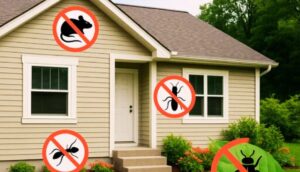Spotted Lanternfly Suppression Robotics Lanternet Review: Is This the Future of Pest Control?

If you’ve spotted colorful pests swarming your trees and garden, you might be dealing with the invasive spotted lanternfly. This pest has become a serious threat to plants, trees, and crops across the U.S., especially in the Northeast. But what if we told you that robots are stepping in to help?
Enter the world of the Lanternet, an innovative lanternfly suppression robot developed to stop these garden pests in their tracks before they take over your garden.
In this detailed review, we’ll cover everything you need to know about Lanternet: how it works, its pros and cons, how it compares to traditional methods, and whether it’s worth the investment. We’ll also answer the top 10 frequently asked questions about this high-tech pest control solution.
So, whether you’re a homeowner, gardener, or orchard manager, stick around. This might be the game-changer you’ve been waiting for to bring these garden pests under control.
What Is the Lanternet?
The Lanternet is a cutting-edge robot designed to help control and suppress populations of spotted lanternflies. Created by researchers at Carnegie Mellon University in partnership with other entomology experts, this robot uses a smart blend of machine vision, UV light, and autonomous mobility to detect, attract, and destroy spotted lanternflies.
Unlike pesticides that can harm beneficial insects, the Lanternet targets only lanternflies. It works by mimicking the insects’ natural attractants and luring them into its trap before delivering a lethal dose of heat or suction.
Why Is This Important?
Spotted lanternflies are not just annoying—they are destructive. These garden pest feed on more than 70 types of plants, from apples, grapes, and hardwoods. Their sugary excrement, known as honeydew, promotes a black mold growth and attracts other pests.
Because of how fast they reproduce and spread, the U.S. Department of Agriculture considers them a serious threat to agriculture and ecosystems. And let’s be honest—who wants their backyard turned into a buzzing infestation zone?
How Does the Lanternet Work?
The Lanternet robot uses a smart combination of tech to get the job done:
-
Visual AI Detection: A computer vision system scans trees, leaves, and branches for spotted lanternflies using pattern recognition.
-
Luring System: Once a lanternfly is spotted, the robot will emit a UV light and heat signature that mimics the conditions lanternflies are drawn to.
-
Vacuum or Heat Trap: Depending on the model, the robot then captures or eliminates the pest using suction or a targeted thermal pulse.
-
Autonomous Navigation: It moves independently around a set area, like a vineyard or backyard, detecting and neutralizing lanternflies without human control.
Not only is this system smart, but it’s also environmentally responsible. It avoids chemicals entirely and works 24/7 if needed.
Develop by a team from Carnegie Mellon University’s Robotics Institute
Key Features of the Lanternet
Let’s take a closer look at what makes this robotic lanternfly hunter so impressive:
✅ Advanced AI Vision
It doesn’t just guess. Lanternet uses trained AI models to accurately spot lanternflies, even when they’re camouflaged.
✅ Silent & Non-Toxic
No buzzing noises. No sprays. It’s a quiet operator that gets the job done safely.
✅ Smart Tracking
It keeps records of where infestations occur most frequently, helping you build a long-term pest strategy.
✅ Mobile-Friendly Dashboard
Yes, you can control and track it from your phone or tablet. That’s futuristic pest control right in your palm.
✅ Solar-Powered Option
For outdoor areas like vineyards or orchards, the solar-powered model ensures continuous operation.
Pros and Cons of the Lanternet
Let’s be real. No product is perfect. Here’s what we loved—and what could be better.
Pros:
-
Eco-Friendly: Zero pesticides or harmful runoff.
-
Precise Targeting: Only lanternflies are affected.
-
Low Maintenance: Just set it and forget it.
-
Works Day & Night: Lanternflies don’t stand a chance.
-
Custom Zones: Set up specific areas for focused suppression.
Cons:
-
Higher Price Tag: It’s an investment.
-
Limited Availability: Currently available only in select regions.
-
Requires Wi-Fi for Full Functionality: Rural users may need a hotspot.
-
Not Ideal for Tiny Gardens: It works best in medium to large areas.
Real-World Applications
Here’s where the Lanternet really shines:
-
Backyards: Tired of bugs ruining your patio? Let Lanternet patrol your yard while you relax.
-
Orchards: Protect high-value crops like apples, peaches, and grapes.
-
Vineyards: Spotted lanternflies love grapevines. This robot protects your wine’s future.
-
City Parks: Municipalities are starting to test Lanternet as a low-maintenance pest solution.
-
Public Gardens & Zoos: Ideal for spaces where chemicals aren’t an option.
Lanternet vs. Traditional Methods
| Feature | Lanternet | Traditional Pesticides |
|---|---|---|
| Eco-Friendly | ✅ Yes | ❌ No |
| Targets Only Lanternflies | ✅ Yes | ❌ Often harms pollinators |
| Maintenance | 🔁 Minimal | 🧪 Repeated sprays needed |
| Cost Over Time | 💲 High upfront, low ongoing | 💲 Lower upfront, recurring |
| Effectiveness | ⭐⭐⭐⭐⭐ | ⭐⭐⭐ |
Clearly, the Lanternet outperforms in key areas—especially for those who want a long-term, hands-off solution.
10 Frequently Asked Questions (FAQs)
1. How much does the Lanternet cost?
Prices start around $999 for the base model. Larger area models or solar-powered versions can range up to $2,500.
2. Is it safe for pets and children?
Yes. The robot only targets lanternflies and has built-in sensors to avoid pets, kids, and humans.
3. How large of an area can it cover?
The standard model can cover up to one acre. Larger commercial models handle 2–5 acres.
4. Does it work at night?
Absolutely. It’s designed for 24/7 operation and uses infrared sensors in low light.
5. Can it run on solar power?
Yes! Some models come with solar charging panels—perfect for farms and rural properties.
6. Is there a warranty?
Lanternet comes with a 1-year limited warranty, covering all major components and firmware updates.
7. Does it require an internet connection?
To use the mobile dashboard and analytics features, you’ll need Wi-Fi or cellular access. Offline mode is available, but with limited functionality.
8. Is it easy to set up?
Yes. Setup takes about 15–20 minutes. Most users can set it up without professional help.
9. Does it harm other bugs?
No. Its AI model is trained to identify only spotted lanternflies, avoiding bees, butterflies, and other insects.
10. Where can I buy it?
Currently, it’s available on the Lanternet official website, select agricultural supply stores, and limited partners in high-infestation zones.
Is the Lanternet Worth It?
If you’re tired of losing your trees, crops, or sanity to spotted lanternflies, the Lanternet is a smart, long-term investment. While the upfront cost is higher than sprays or traps, its precision, eco-friendliness, and automated operation make it a standout.
Whether you’re a tech enthusiast, farmer, or eco-conscious homeowner, the Lanternet brings innovation and relief. Plus, as lanternfly populations continue to spread, being proactive can save you far more in the long run.
Conclusion
Spotted lanternflies are more than a nuisance—they’re a full-blown problem that can turn a dream garden into a nightmare. The Lanternet robot offers a refreshing new solution that combines cutting-edge AI with sustainable pest control.
It’s safe. It’s smart. And it could just be the future of how we protect our trees, crops, and outdoor spaces.
If you’re serious about pest suppression—and ready to say goodbye to the toxic chemicals—Lanternet is worth a serious look.
Ready to Act?
Protect your home and garden from spotted lanternflies before they take over. Let the robot do the work—while you enjoy the peace.












Wow, I have not experienced the spotted lanternfly, however, as an avid gardener I am all too familiar with the never-ending battle against unwanted guests. This seems like such a fantastic solution, like a Roomba for outdoor pests, and I love that there are models that run on solar power. Do you see the possibility for this product being adapted for use with other pests as well? I could really get behind a product that would offer a hands off approach to pest control. How far off do you feel this technology is from becoming an available option for the average home gardener? What do you think—will robots like this become a common sight in home gardens within the next decade?
Well, according to the manufacturer, the robot was designed for a specific insect species. According to how technology is going it is possible.